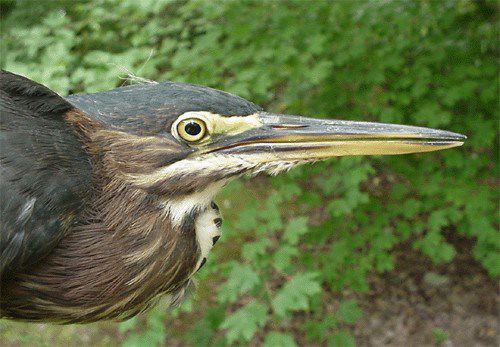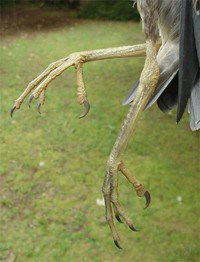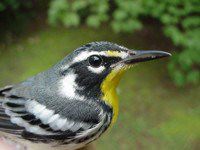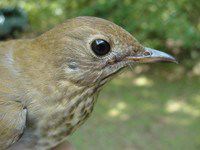|
|
|||
|
THIS WEEK at HILTON POND (Back to Preceding Week; on to Next Week) |

All text & photos © Hilton Pond Center One of the great things about bird banding is being able to capture wild birds to examine them in detail. Often, peering at a bird in a tree through binoculars doesn't really provide a look at the true essence of the plumage, the eye color, or other physical characteristics that make a bird distinctive. That's why it was really exciting this week to handle the tenth Green Heron banded at Hilton Pond Center since 1982, an immature bird (above) that may have been produced locally.
Banding herons of any size is always a challenge. Most are aggressive and squirm continuously, making it hard to hold the long legs and sinuous neck. Heron-banding is also potentially dangerous, since herons and egrets typically aim their elongated beaks toward an enemy's eyes when threatened. Several years ago, Center director Bill Hilton Jr. was photographing a just-banded Green Heron at Hilton Pond. Gripping the bird in his left hand and a camera in his right, Hilton looked away to make a focusing adjustment and in a split-second the heron extended its neck and struck Hilton in the temple with its beak. Despite the small size of the heron, it was able to exert considerable force against this sensitive spot, and Hilton saw stars and nearly went to his knees. Had his head been turned an inch closer to the heron, the bill likely would have punctured Hilton's eyeball--a steep price to pay for getting a close view of this fascinating wading bird. All text & photos © Hilton Pond Center |

 Once called "Green-backed Heron," the crow-sized Green Heron,Butorides virescens, is the second-smallest "wading bird" that regularly occurs in the continental U.S. (Only the Least Bittern is smaller.) It's also one of the most common waders in both fresh and salt water habitats, including small ponds and wooded streams around which the wingspans of larger birds would prevent safe flight. Its primary food is small fish, dragonflies, crayfish, and occasional small snakes and mice. Unlike many waders that breed in colonies, the Green Heron usually is a solitary nester, building a loose platform of sticks about 10-15 feet above the ground in a pine or hardwood tree--often some distance from the water.
Once called "Green-backed Heron," the crow-sized Green Heron,Butorides virescens, is the second-smallest "wading bird" that regularly occurs in the continental U.S. (Only the Least Bittern is smaller.) It's also one of the most common waders in both fresh and salt water habitats, including small ponds and wooded streams around which the wingspans of larger birds would prevent safe flight. Its primary food is small fish, dragonflies, crayfish, and occasional small snakes and mice. Unlike many waders that breed in colonies, the Green Heron usually is a solitary nester, building a loose platform of sticks about 10-15 feet above the ground in a pine or hardwood tree--often some distance from the water. On the wing, a Green Heron looks very dark, and while wading or perching appears blue rather than green; an in-the-hand view (above left) makes its name more understandable. The sides of the short, serpentine neck are chestnut-red, with a white throat. The legs--and their long, skinny toes--are bright yellow or orange (right), especially in breeding adults. The Green Heron has distinctive deep wing beats and often utters a deep "skeow" call while flying overhead.
On the wing, a Green Heron looks very dark, and while wading or perching appears blue rather than green; an in-the-hand view (above left) makes its name more understandable. The sides of the short, serpentine neck are chestnut-red, with a white throat. The legs--and their long, skinny toes--are bright yellow or orange (right), especially in breeding adults. The Green Heron has distinctive deep wing beats and often utters a deep "skeow" call while flying overhead.


